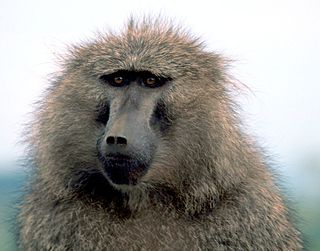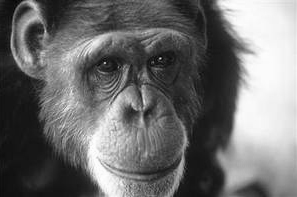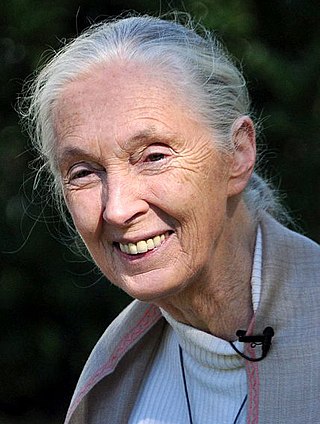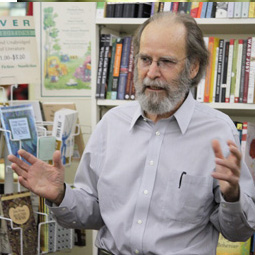Related Research Articles

The chimpanzee, also known as simply the chimp, is a species of great ape native to the forest and savannah of tropical Africa. It has four confirmed subspecies and a fifth proposed one. When its close relative the bonobo was more commonly known as the pygmy chimpanzee, this species was often called the common chimpanzee or the robust chimpanzee. The chimpanzee and the bonobo are the only species in the genus Pan. Evidence from fossils and DNA sequencing shows that Pan is a sister taxon to the human lineage and is humans' closest living relative. The chimpanzee is covered in coarse black hair, but has a bare face, fingers, toes, palms of the hands, and soles of the feet. It is larger and more robust than the bonobo, weighing 40–70 kg (88–154 lb) for males and 27–50 kg (60–110 lb) for females and standing 150 cm.

Dame Jane Morris Goodall, formerly Baroness Jane van Lawick-Goodall, is an English primatologist and anthropologist. She is considered the world's foremost expert on chimpanzees, after 60 years studying the social and family interactions of wild chimpanzees. Goodall first went to Gombe Stream National Park in Tanzania to observe its chimpanzees in 1960.

The genus Pan consists of two extant species: the chimpanzee and the bonobo. Taxonomically, these two ape species are collectively termed panins. The two species were formerly collectively called "chimpanzees" or "chimps"; if bonobos were recognized as a separate group at all, they were referred to as "pygmy chimpanzees". Together with humans, gorillas, and orangutans they are part of the family Hominidae. Native to sub-Saharan Africa, chimpanzees and bonobos are currently both found in the Congo jungle, while only the chimpanzee is also found further north in West Africa. Both species are listed as endangered on the IUCN Red List of Threatened Species, and in 2017 the Convention on Migratory Species selected the chimpanzee for special protection.

Primatology is the scientific study of primates. It is a diverse discipline at the boundary between mammalogy and anthropology, and researchers can be found in academic departments of anatomy, anthropology, biology, medicine, psychology, veterinary sciences and zoology, as well as in animal sanctuaries, biomedical research facilities, museums and zoos. Primatologists study both living and extinct primates in their natural habitats and in laboratories by conducting field studies and experiments in order to understand aspects of their evolution and behavior.

Washoe was a female common chimpanzee who was the first non-human to learn to communicate using American Sign Language (ASL) as part of an animal research experiment on animal language acquisition.
Irven DeVore was an anthropologist and evolutionary biologist, and Curator of Primatology at Harvard University's Peabody Museum of Archaeology and Ethnology. He headed Harvard's Department of Anthropology from 1987 to 1992. He taught generations of students at Harvard both at the undergraduate and graduate levels. He mentored many young scientists who went on to prominence in anthropology and behavioral biology, including Richard Lee, Robert Trivers, Sarah Hrdy, Peter Ellison, Barbara Smuts, Henry Harpending, Marjorie Shostak, Robert Bailey, Leda Cosmides, John Tooby, Richard Wrangham and Terrence Deacon.

The olive baboon, also called the Anubis baboon, is a member of the family Cercopithecidae Old World monkeys. The species is the most wide-ranging of all baboons, being native to 25 countries throughout Africa, extending from Mali eastward to Ethiopia and Tanzania. Isolated populations are also present in some mountainous regions of the Sahara. It inhabits savannahs, steppes, and forests. The common name is derived from its coat colour, which is a shade of green-grey at a distance. A variety of communications, vocal and non-vocal, facilitate a complex social structure.

Gombe Stream National Park is a national park in Kigoma District of Kigoma Region in Tanzania, 16 km (10 mi) north of Kigoma, the capital of Kigoma Region. Established in 1968, it is one of the smallest national parks in Tanzania, with only 35 km2 (13.5 sq mi) of protected land along the hills of the eastern shore of Lake Tanganyika. The terrain is distinguished by steep valleys, and the vegetation ranges from grassland to woodland to tropical rainforest. Accessible only by boat, the park is most famous as the location where Jane Goodall pioneered her behavioural research on the common chimpanzee populations. The Kasakela chimpanzee community, featured in several books and documentaries, lives in Gombe National Park.

Social grooming is a behavior in which social animals, including humans, clean or maintain one another's body or appearance. A related term, allogrooming, indicates social grooming between members of the same species. Grooming is a major social activity, and a means by which animals who live in close proximity may bond and reinforce social structures, family links, and build companionships. Social grooming is also used as a means of conflict resolution, maternal behavior and reconciliation in some species. Mutual grooming typically describes the act of grooming between two individuals, often as a part of social grooming, pair bonding, or a precoital activity.

Richard Walter Wrangham is an English anthropologist and primatologist; he is Professor of Biological Anthropology at Harvard University. His research and writing have involved ape behavior, human evolution, violence, and cooking.

The Trimates, sometimes called Leakey's Angels, is a name given to three women — Jane Goodall, Dian Fossey, and Birutė Galdikas — chosen by anthropologist Louis Leakey to study primates in their natural environments. They studied chimpanzees, gorillas and orangutans, respectively.

The Jane Goodall Institute (JGI) is a global non-profit wildlife and environment conservation organization headquartered in Washington, DC. It was founded in 1977 by English primatologist Jane Goodall and Genevieve di San Faustino (1919-2011). The institute's mission is to improve the treatment and understanding of primates through public education and legal representation, to protect their habitats in partnership with local communities, and to recruit and train young people for these missions.

Tool use by non-humans is a phenomenon in which a non-human animal uses any kind of tool in order to achieve a goal such as acquiring food and water, grooming, combat, defence, communication, recreation or construction. Originally thought to be a skill possessed only by humans, some tool use requires a sophisticated level of cognition. There is considerable discussion about the definition of what constitutes a tool and therefore which behaviours can be considered true examples of tool use. A wide range of animals, including mammals, birds, fish, cephalopods, and insects, are considered to use tools.
The Kasekela chimpanzee community is a habituated community of wild eastern chimpanzees that lives in Gombe National Park near Lake Tanganyika in Tanzania. The community was the subject of Jane Goodall's pioneering study that began in 1960, and studies have continued ever since, becoming the longest continuous study of any animals in their natural habitat. As a result, the community has been instrumental in the study of chimpanzees and has been popularized in several books and documentaries. The community's popularity was enhanced by Goodall's practice of giving names to the chimpanzees she was observing, in contrast to the typical scientific practice of identifying the subjects by number. Goodall generally used a naming convention in which infants were given names starting with the same letter as their mother, allowing the recognition of matrilineal lines.

Dale Peterson is an American author who writes about scientific and natural history subjects.

Sexual swelling, Sexual skin,or Anogenital tumescence refers to localized engorgement of the anus and genital region of some female primates that vary in size over the course of the menstrual cycle. Thought to be an honest signal of fertility, male primates are attracted to these swellings; preferring, and competing for, females with the largest swellings.

Toshisada Nishida was a Japanese primatologist who established one of the first long term chimpanzee field research sites. He was the first to discover that chimpanzees, instead of forming nuclear family-like arrangements, live a communal life with territorial boundaries. His discoveries of the medicinal use of plants by wild chimpanzees helped form the basis of the field of zoopharmacognosy.
Sexual coercion among animals is the use of violence, threats, harassment, and other tactics to help them forcefully copulate. Such behavior has been compared to sexual assault, including rape, among humans.
The Gombe Chimpanzee War, also known as the Four-Year War, was a violent conflict between two communities of chimpanzees in Gombe Stream National Park in the Kigoma region of Tanzania between 1974 and 1978. The two groups were once unified in the Kasakela community. By 1974, researcher Jane Goodall noticed the community splintering. Over a span of eight months, a large party of chimpanzees separated themselves into the southern area of Kasakela and were renamed the Kahama community. The separatists consisted of six adult males, three adult females and their young. The Kasakela was left with eight adult males, twelve adult females and their young.
Anne Elizabeth Pusey is director of the Jane Goodall Institute Research Center and a professor of evolutionary anthropology at Duke University. Since the early 1990s, Pusey has been archiving the data collected from the Gombe chimpanzee project. The collection housed at Duke University consists of a computerized database that Pusey oversees. In addition to archiving Jane Goodall’s research from Gombe, she is involved in field study and advising students at Gombe. She was elected a member of the National Academy of Sciences in 2022.
References
- 1 2 "Alice Smuts Obituary (1921 - 2020) Ann Arbor News". Legacy.com. Retrieved 2021-08-29.
- ↑ Profile Archived 2009-03-22 at the Wayback Machine at the Council of Human Development
- ↑ Goodall, Jane (2001). Dale Peterson (ed.). Jane Goodall-Beyond Innocence: An Autobiography in Letters, the later years . New York: Houghton Mifflin Company. pp. 146–147. ISBN 0-618-12520-5 . Retrieved 28 April 2010.
smuts.
- ↑ "APA Distinguished Scientific Awards for an Early Career Contribution to Psychology". www.apa.org. Retrieved 2023-09-24.
- 1 2 "Barbara Smuts". Center for Humans & Nature. Retrieved 2021-08-29.
- ↑ Smuts, B.B. (2009) [First printing 1985]. Sex and Friendship in Baboons . New York: Aldine Publishing Co. p. 5. ISBN 978-0-202-02027-3.
Sex and Friendship in Baboons .
- ↑ Smuts, Barbara B (1985). Sex and Friendship in Baboons . Aldine. ISBN 0-202-02027-4.
- ↑ Mann, Janet; Barbara Smuts (1999). "Behavioral development in wild bottlenose dolphin newborns (Tursiops sp.)". Behaviour. Netherlands: E J Brill. 136 (5): 529–566. doi:10.1163/156853999501469. ISSN 0005-7959.
- ↑ Barbara Smuts research profile at UMich.edu
- ↑ "Barbara Smuts | U-M LSA Department of Psychology". lsa.umich.edu. Retrieved 2021-08-29.